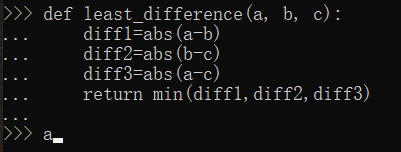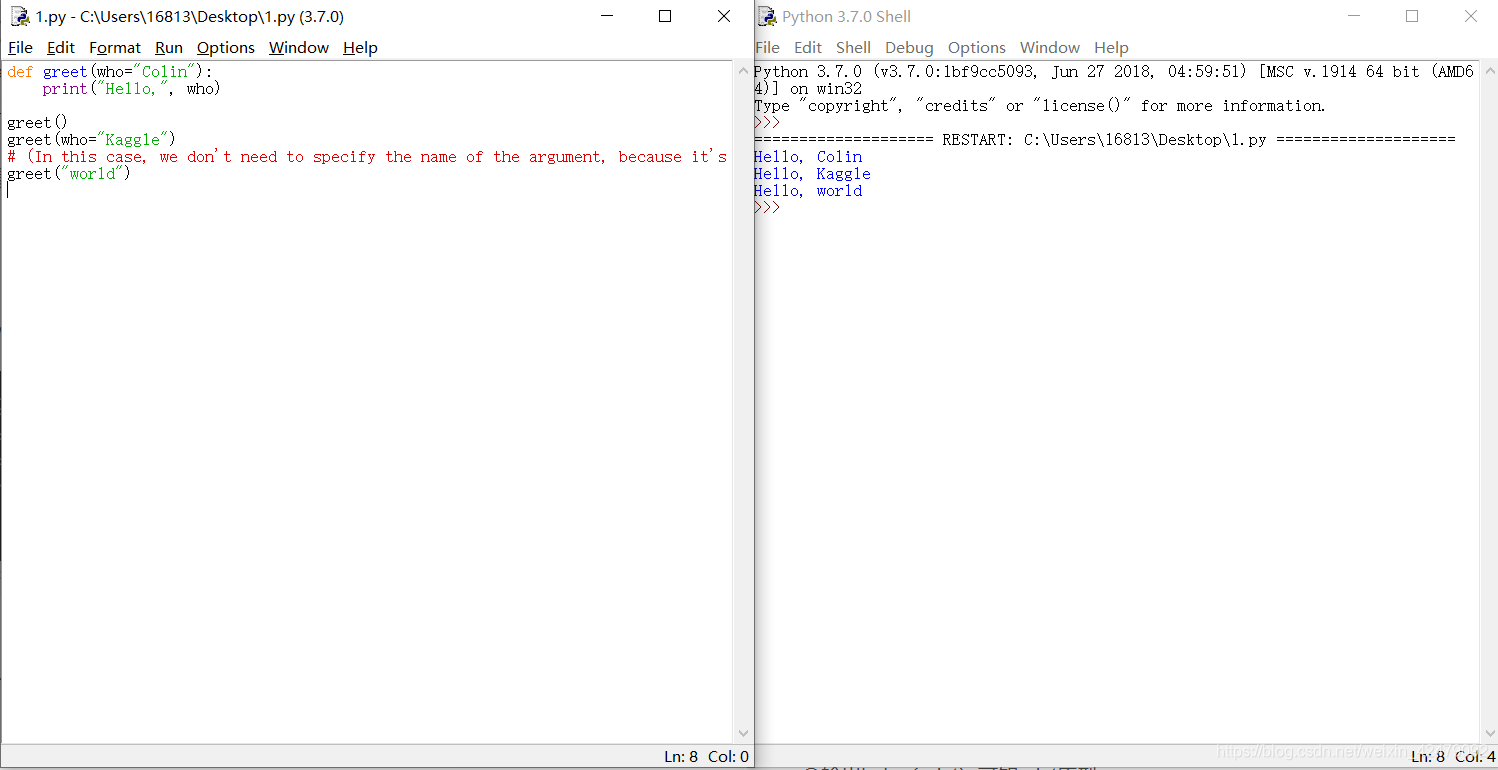【Kaggle Learn】Python https://www.kaggle.com/learn/python
一. Hello, Python
A quick introduction to Python syntax, variable assignment, and numbers
spam_amount = 0
print(spam_amount)
# Ordering Spam, egg, Spam, Spam, bacon and Spam (4 more servings of Spam)
spam_amount = spam_amount + 4
if spam_amount > 0:
print("But I don't want ANY spam!")
viking_song = "Spam " * spam_amount
print(viking_song)
"""
The result is:
0
But I don't want ANY spam!
Spam Spam Spam Spam
"""
①无分号 ;
②printf()
③if a>0 :
printf()
if语句用冒号 :
④注释单行用#,注释多好用三个 ’ 单引号或三个 " 双引号
⑤注意要用英文字符
⑥变量无需定义类型,字符串可直接相乘,如"Spam"*4
另外也可以用type()得出当前变量的类型
①c语言以及matlab的基本操作可以用在python上,还有a//b,a**b,-a
a//b : a/b去小数
a ** b : a^b
-a : a的相反数
②printf()用法
print("Height in meters =", total_height_meters, "?")
#Height in meters = 26.9 ?
③其他函数
min()
max()
abs()
float()
int()
二. Exercise: Syntax, Variables, and Numbers
略
三. Functions and Getting Help
Calling functions and defining our own, and using Python’s builtin documentation
round() 浮点数四舍五入,可多小数位
定义函数
def least_difference(a, b, c):
diff1 = abs(a - b)
diff2 = abs(b - c)
diff3 = abs(a - c)
return min(diff1, diff2, diff3)
①def语句也要用冒号 :
②输入多行代码
(1)命令行下
在 : 后面按回车,然 后按Tab,打代码,按回车,以此类推,最后按两次回车。

(2)记事本转.py后, 打开python shell, 写代码, 按F5或Run-Run module
此时的def也要有一个Tab缩进(其实空格也行 不好看…)

③docstrings 其实就是注释
要善于写注释
④当def里面没有return 此时用print(def(1,2,3)) 输出None
⑤输出help(print)可知print原型
print(value, ..., sep=' ', end='\n', file=sys.stdout, flush=False)
不改即为默认值
如:
print(1, 2, 3)
1 2 3
print(1, 2, 3, sep=' < ')
1 < 2 < 3
也可这样用print
print(
call(mult_by_five, 1),
squared_call(mult_by_five, 1),
sep='\n', # '\n' is the newline character - it starts a new line
)
调用函数
def greet(who="Colin"):
print("Hello,", who)
greet()
greet(who="Kaggle")
# (In this case, we don't need to specify the name of the argument, because it's unambiguous.)
greet("world")
"""
The result is:
Hello, Colin
Hello, Kaggle
Hello, world
"""
调用方式很多
(1)定义函数时可以用其他函数
def mult_by_five(x):
return 5 * x
#相当于调用一次mult_by_five(x)
def call(fn, arg):
"""Call fn on arg"""
return fn(arg)
#相当于调用一次mult_by_five( mult_by_five(x) )
def squared_call(fn, arg):
"""Call fn on the result of calling fn on arg"""
return fn(fn(arg))
print(
call(mult_by_five, 1),
squared_call(mult_by_five, 1),
sep='\n', # '\n' is the newline character - it starts a new line
)
"""
The result is:
5
25
"""
(2)调用函数(如max函数)时用其他函数
def mod_5(x):
"""Return the remainder of x after dividing by 5"""
return x % 5
print(
'Which number is biggest?',
max(100, 51, 14),
'Which number is the biggest modulo 5?',
#通过改变key,使max函数先对数进行mod5,操作再取最大值
max(100, 51, 14, key=mod_5),
sep='\n',
)
#max原型为 max(arg1, arg2, *args, *[, key=func]) -> value
"""
The result is:
Which number is biggest?
100
Which number is the biggest modulo 5?
14
"""
四. Exercise: Functions and Getting Help
round原型round(number, ndigits=None)
①当ndigits为正数, 对小数点后n位四舍五入
如
>>> round(1.0016,3)
1.002
>>> round(1.0014,3)
1.001
①当ndigits为负数, 对小数点前n位四舍五入
如
>>> round(2166086,-3)
2166000
>>> round(2166086,-2)
2166100
>>>
Tip: In the kernel editor, you can highlight several lines and press ctrl+/ to toggle commenting.
time函数用法【略】
①
The time function returns the number of seconds that have passed since the Epoch (aka [Unix time]).
Epoch:January 1, 1970, 00:00:00 (UTC)
from time import time
t = time()
print(t, "seconds since the Epoch")
#1550835855.8225462 seconds since the Epoch
#1550835865.3415313 seconds since the Epoch
②停几秒再输出,用sleep()
from time import sleep
duration = 5
print("Getting sleepy. See you in", duration, "seconds")
sleep(duration)
print("I'm back. What did I miss?")
#Getting sleepy. See you in 5 seconds
#这里经过了5秒
#I'm back. What did I miss?
③计算调用某个函数用了多久,用time()
def time_call(fn, arg):
"""Return the amount of time the given function takes (in seconds) when called with the given argument.
"""
pass
t0 = time()
fn(arg)
t1 = time()
elapsed = t1 - t0
return elapsed
"""
def time_call(fn, arg1,arg2):
pass
t0 = time()
fn(arg1,arg2)
t1 = time()
elapsed = t1 - t0
return elapsed
print(time_call(max,1,2))
9.5367431640625e-07
"""





 本教程为Python初学者提供了一个快速入门,涵盖了语法、变量、数字处理、函数定义及调用等核心概念。从Hello World到自定义函数,深入浅出地讲解了Python的基本操作和常用函数,如round()、min()、max()等,并介绍了如何获取帮助。
本教程为Python初学者提供了一个快速入门,涵盖了语法、变量、数字处理、函数定义及调用等核心概念。从Hello World到自定义函数,深入浅出地讲解了Python的基本操作和常用函数,如round()、min()、max()等,并介绍了如何获取帮助。
















 5373
5373

 被折叠的 条评论
为什么被折叠?
被折叠的 条评论
为什么被折叠?








